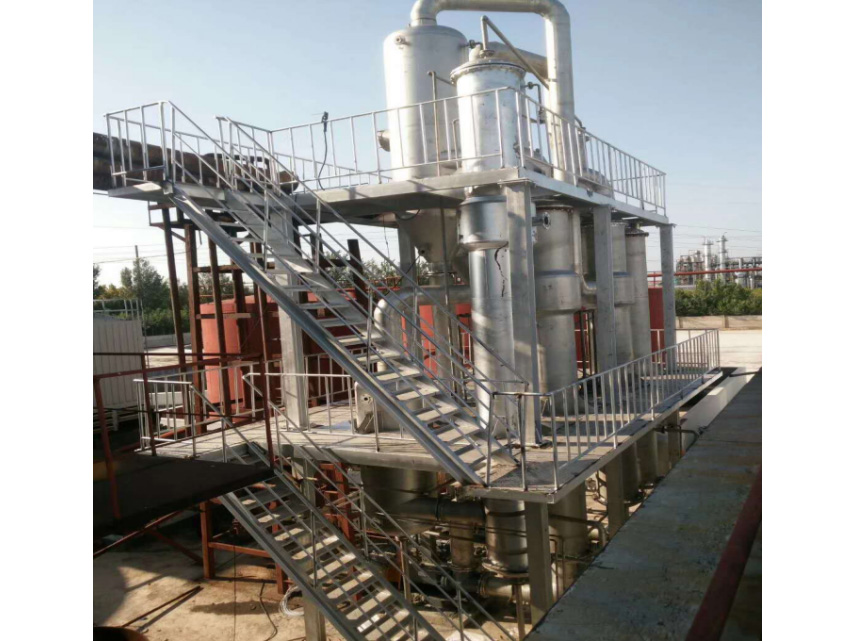First, the system equipment uses:
It is suitable for the evaporation and crystallization of poorly flowing, easily crystallizable materials (eg, sodium chloride crystals, ammonium sulfate crystals, barium chloride crystals, copper sulfate solutions, nickel sulfate solutions, and sodium sulfate solutions).
Second, system equipment overview:
Forced circulation evaporators rely on an external force - a circulation pump to circulate the liquid. Its heating chamber has two kinds of horizontal and vertical structure, the liquid circulation speed is regulated by the pump. According to the position of the separation chamber circulation liquid inlet and outlet, it can be divided into positive circulation forced vaporizer and reverse circulation forced vaporizer. The circulation material liquid inlet position is called the positive circulation in the upper part of the outlet position, and vice versa is the reverse circulation. Reverse circulation forced evaporator has more advantages. The circulating flow rate of the liquid in the heating tube is usually in the range of 1.2~3.0 m/s (When the suspension has many crystal grains, the hardness of the used pipe is low, the liquid viscosity is larger, the low value is selected), and the heating pipe may be a vertical one-way , Vertical two-way, horizontal one-way, horizontal two-way, the total height of the latter two devices is small, but the pipe is not easy to clean and easy to wear the pipe wall. The head of the circulating pump must match the resistance of the circulatory system, and generally the flow has a large head. Since the solution temperature is close to the boiling point, cavitation problems should be paid attention to when selecting the pump. Forced circulation evaporators are used to avoid scale formation or crystallization of products boiling on the heating surface, for which reason the flow speed in the tubes must be high. When the circulating liquid flows through the heat exchanger, it is heated and then partially evaporated as the pressure of the separator decreases, thereby cooling the liquid to the boiling temperature corresponding to the pressure. Due to the circulation pump, the operation of the evaporator is basically irrelevant to the temperature difference. The recirculation speed of the material can be precisely adjusted. The evaporation rate is set within a certain range. In crystallization applications, crystals can be separated from circulating crystal mud by adjusting the circulation flow rate and using a special separator design. The equipment adopts forced circulation of the pump, which has a high evaporation rate and a large concentration ratio, and is particularly suitable for the evaporation of materials with high concentration or high viscosity.
Third, the system equipment components:
Evaporation system Evaporator, separator, condenser, circulation pump, waste heat recovery and utilization device, connecting pipe and vacuum system, equipment support, operation platform and other components. The vacuum system can be equipped with a water jet or a vacuum pump or a vacuum all-in-one with other equipment.
Fourth, the main technical parameters of the system are as follows:
Evaporation capacity (Kg/h water) - 500/1000/2000/4000/6000/8000/10000
Heating steam pressure (MPa) - 0.2 ~ 0.6
Steam consumption (Kg/h) - 270-5200
Water consumption (t/h) - 5 to 200 tons (circulating cooling water)
Fifth, the characteristics of multi-effect forced circulation evaporation system:
1. The material properties of the relative treatment of the equipment can be adapted to a wide range. Among them, materials that are prone to fouling in the evaporation process, materials that crystallize out of the evaporation process, materials that increase in concentration, viscosity, and materials that have insoluble solids, etc.;
2. In the process of evaporation, the material is heated and forced to circulate. The tube has fast flow, uniform heat, high heat transfer coefficient, and can prevent dry wall phenomenon.
3. The feed solution is rapidly heated by the heater through a forced circulation pump, and the top comes out directly into the evaporative separator through a tangential type, and the vapor-liquid separation effect is good.
4, the material through the device evaporation and condensation, vacuum evaporation and low-temperature evaporation, plus continuous in and out of material, heating and evaporation time is short, but also adapted to food sauce material heat-sensitive evaporation concentration.
5, the device structure is compact, small footprint, smooth layout, easy operation, stable performance and so on.
6. The equipment can be equipped with automatic system to realize automatic control of feed quantity, automatic control of heating temperature, automatic control of discharging concentration, and can also be equipped with sudden power failure, protection measures against sensitive materials in case of failure, and other automation operations such as safety and alarm. ,control.
7. Make full use of waste heat. Through the proper connection of system connection and temperature difference, the utilization efficiency of heat source can be effectively improved.




